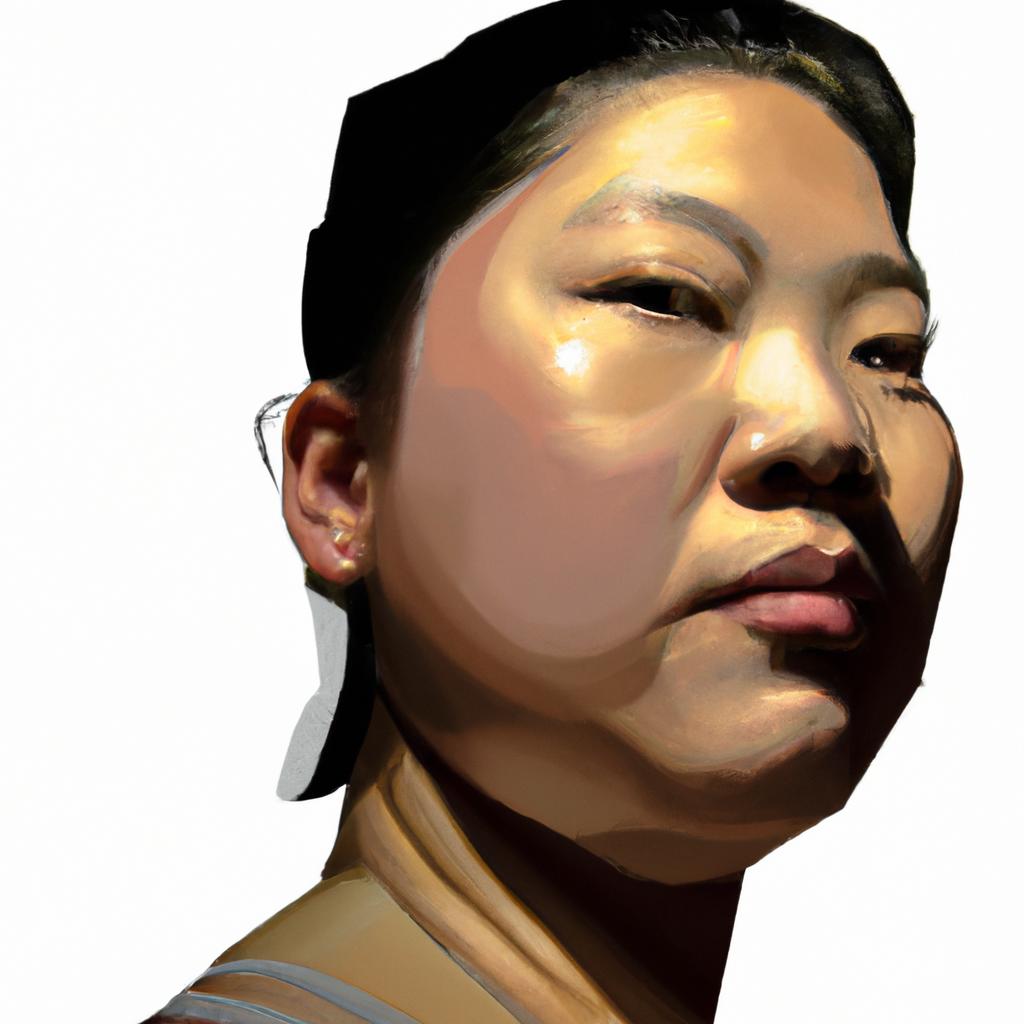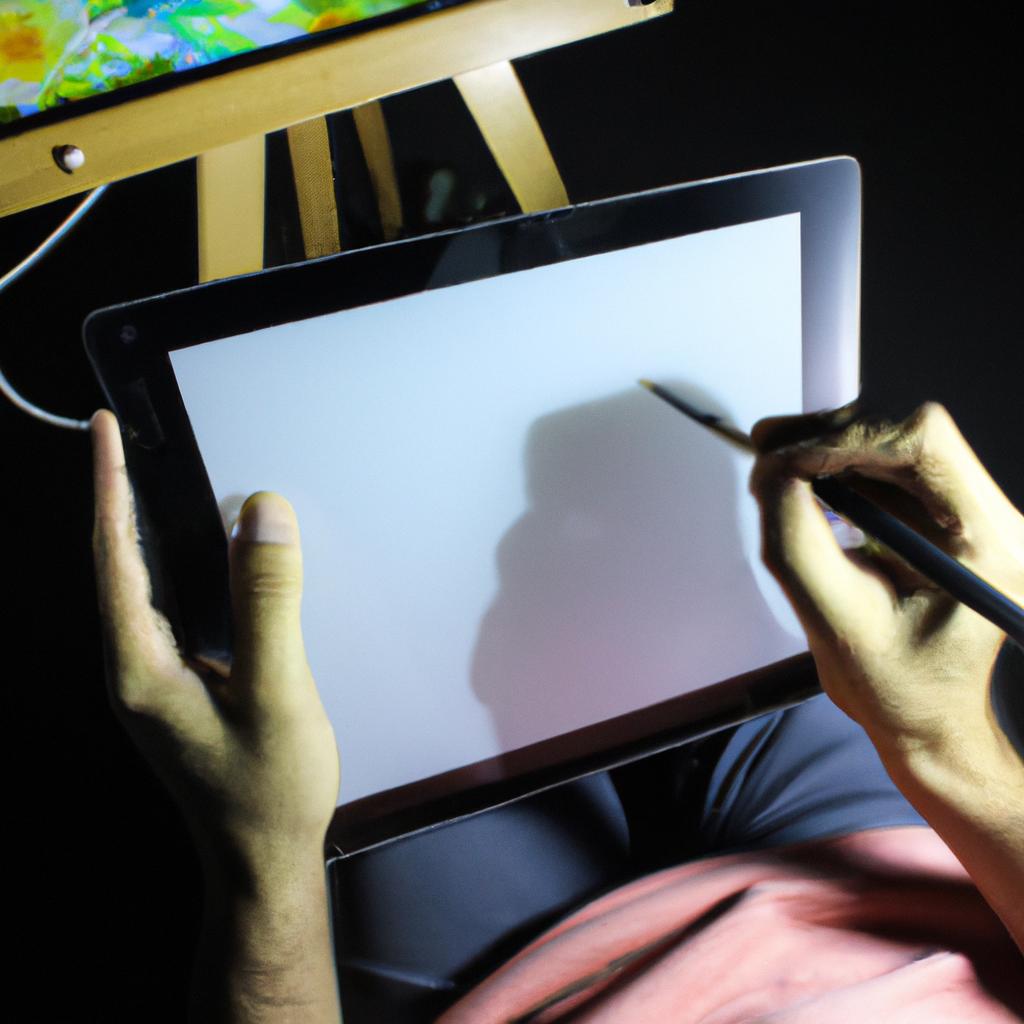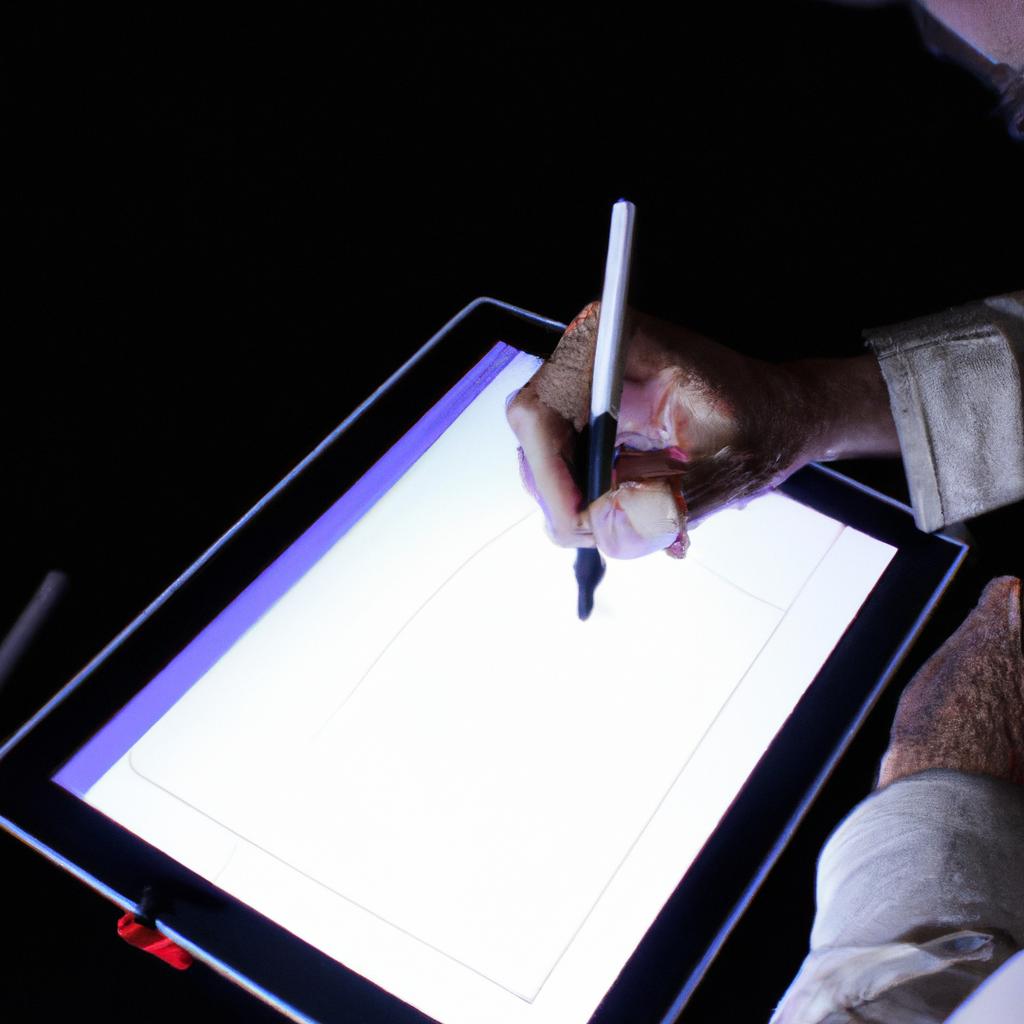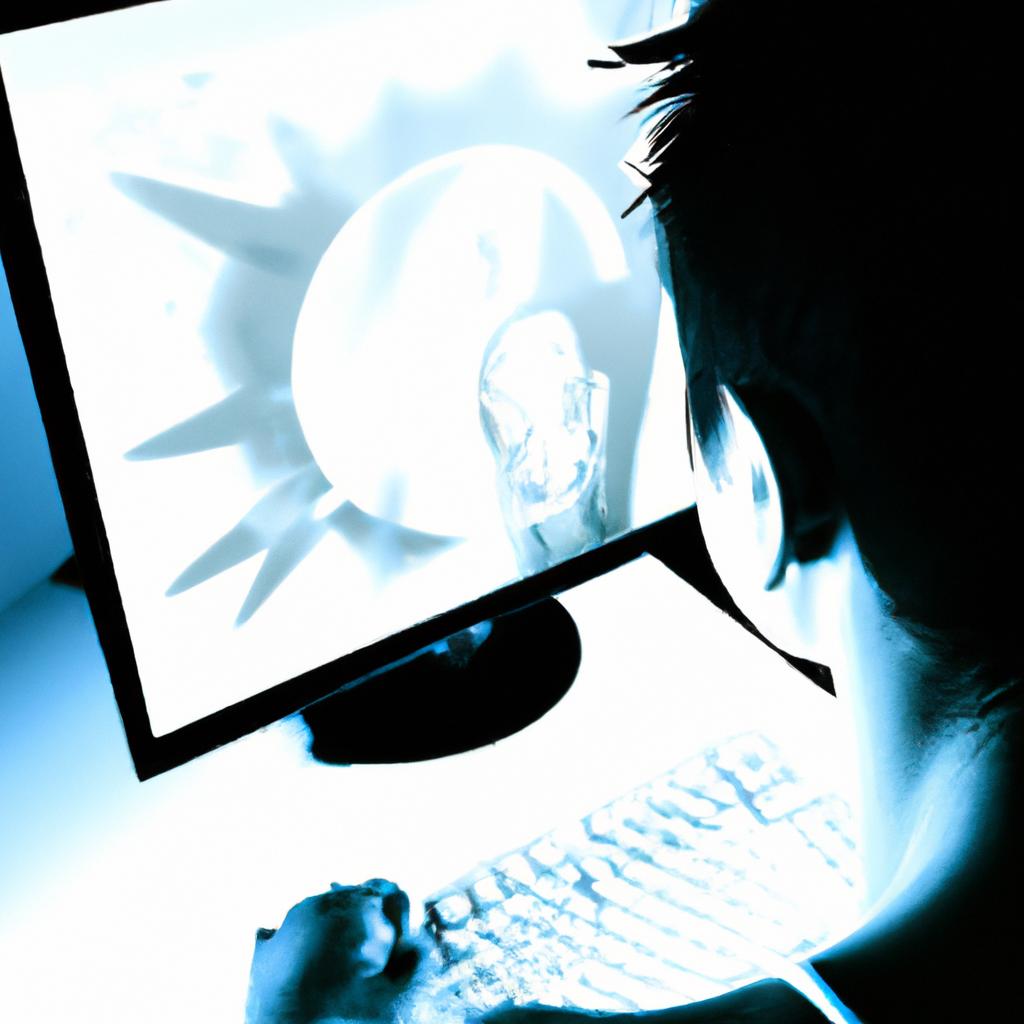Digital painting has emerged as a prominent medium in the field of arts and illustration, offering artists new possibilities for creativity and expression. Through the use of digital tools such as tablets, styluses, and software programs, artists can manipulate colors, textures, and brush strokes with ease. This article aims to explore various composition techniques utilized in digital painting that enhance the visual impact and storytelling aspect of artworks.
To illustrate these techniques, consider the hypothetical case study of an artist creating a fantasy landscape using digital painting. By employing principles like rule of thirds and leading lines, the artist can strategically position elements within the artwork to guide viewers’ eyes across the scene and create a sense of depth. Additionally, by understanding color theory and contrast, they can effectively convey mood or atmosphere within their piece. With this example serving as a starting point, we will delve into key composition techniques used in digital painting that enable artists to craft visually captivating illustrations.
Understanding color theory and its application
Color holds a significant role in the world of art and illustration, allowing artists to convey emotions, set moods, and create visually engaging compositions. By understanding color theory and its application, artists can make deliberate choices that enhance their digital paintings. For instance, consider the case of an artist aiming to depict a serene landscape during sunset. In this scenario, knowledge of color theory would enable the artist to select appropriate hues such as warm oranges and purples for the sky, contrasting with cool blues and greens for the surrounding nature.
To evoke emotional responses from viewers, artists employ various techniques when working with colors. One effective approach is using contrasting colors to create visual impact. The juxtaposition of complementary colors like blue and orange or red and green creates vibrancy in a painting while evoking strong feelings of excitement or tension. Another technique involves utilizing analogous colors which are adjacent on the color wheel (e.g., yellow-orange-red). This harmony between closely related hues gives a sense of unity and calmness to the artwork.
Furthermore, incorporating a bullet point list can further engage the audience by providing concise information about how different aspects of color theory affect perception:
- Hue: Different hues evoke distinct emotions; for example, yellow often symbolizes happiness while blue represents tranquility.
- Saturation: High saturation intensifies emotions whereas desaturated tones create a more subdued atmosphere.
- Value: Varying values determine contrast levels and add depth to an artwork.
- Temperature: Warm colors typically suggest energy or warmth while cooler ones elicit feelings of serenity or coldness.
Additionally, a table showcasing examples of color combinations can stimulate an emotional response from readers through visual representation:
| Color Combination | Emotion |
|---|---|
| Red + Black | Power |
| Blue + White | Peace |
| Yellow + Green | Joy |
| Purple + Gold | Royalty |
In conclusion, understanding color theory and its application is crucial for artists and illustrators seeking to create visually impactful digital paintings. By utilizing contrasting colors, analogous harmonies, and considering various elements of color perception such as hue, saturation, value, and temperature, artists can effectively convey emotions and engage viewers on a deeper level. In the subsequent section about “The use of different brushes and brush techniques,” we will explore another significant aspect of composition in digital painting.
(Note: Please note that the markdown formatting for bullet points may not be visible in this plain text format.)
The use of different brushes and brush techniques
Understanding color theory and its application is crucial in the world of digital painting. It allows artists to create visually appealing compositions that evoke specific emotions or moods. Now, let’s delve into the use of different brushes and brush techniques, which further enhance an artist’s ability to bring their vision to life.
One example of a brush technique is the dry brush technique. This involves using a brush with very little paint on it, resulting in a textured effect on the canvas. By lightly dragging the brush across the surface, artists can create rough textures or add highlights to certain areas of their artwork. This technique adds depth and dimension, making the digital painting more realistic and engaging.
To further explore the versatility of brushes, here are some key points to consider:
- Different types of brushes: Artists have access to a wide range of virtual brushes in digital painting software. These include round brushes for smooth lines, flat brushes for broad strokes, and texture brushes for adding unique patterns or effects.
- Brush settings: Adjusting parameters such as size, opacity, flow, and hardness can greatly influence how a brush behaves on the canvas. Experimenting with these settings enables artists to achieve various textures and blending effects.
- Customizing brushes: Many digital painting programs allow users to customize brushes by altering shape dynamics, scattering options, and other settings. This customization empowers artists to develop their own unique style and signature look.
- Layering techniques: Utilizing layers effectively is another aspect of digital painting that impacts brushwork. Artists can work on separate layers for different elements within an artwork (e.g., foreground and background), allowing for easier editing and experimentation without affecting other parts.
By utilizing different brushes and exploring various brush techniques, artists can add depth, texture, and visual interest to their digital paintings. The combination of color theory knowledge from previous sections intertwined with versatile brushwork creates captivating artworks that resonate with viewers emotionally.
Moving forward into our next section about the importance of composition and focal points, we will explore how these elements contribute to the overall impact of a digital painting.
The importance of composition and focal points
In the realm of digital painting, colors play a fundamental role in conveying emotions and enhancing artistic expression. By skillfully manipulating color palettes, artists can evoke specific moods and create visually captivating compositions. To illustrate this concept, let’s consider an example where an artist aims to depict a serene landscape at sunset.
One technique that artists employ is the use of complementary colors to create contrast and visual interest. In our case study, the artist may choose to pair warm hues such as oranges and yellows with cool shades like purples and blues. This juxtaposition creates harmony while simultaneously drawing attention to key elements within the composition—such as the setting sun or silhouettes of trees against an evening sky.
When it comes to digital painting, understanding the psychological impact of different colors becomes crucial for effectively conveying desired emotions. Here are some ways in which colors can influence viewers’ perceptions:
- Red: Associated with passion and intensity.
- Blue: Evokes feelings of calmness and tranquility.
- Green: Symbolizes nature and growth.
- Purple: Often linked to mystery or spirituality.
To demonstrate how color choices affect perception further, consider the following table showcasing various emotional responses associated with different color combinations:
| Color Combination | Emotional Response |
|---|---|
| Yellow + Orange | Warmth |
| Blue + Green | Serenity |
| Red + Black | Power |
| Purple + White | Elegance |
By thoughtfully selecting appropriate color combinations based on their intended emotional impact, digital painters have the power to engage viewers on a deeper level.
As we delve into exploring various layering techniques in our subsequent section about “Exploring various layering techniques,” it is essential to remember that colors serve as the foundation upon which every stroke is built. Through careful consideration of color theory principles and experimentation, artists can employ colors as powerful tools to convey their artistic vision in digital painting.
Exploring various layering techniques
Building upon the understanding of composition and focal points, artists and illustrators can further enhance their digital paintings through the exploration of various layering techniques. By strategically layering elements within an artwork, artists can create depth, texture, and visual interest.
For instance, imagine a landscape painting depicting a serene sunset scene. The artist may begin by creating separate layers for the sky, mountains, trees, and foreground elements such as grass or flowers. By working on each element independently in its own layer, the artist has greater control over color adjustments, blending modes, and overall placement. This approach allows them to experiment with different variations without affecting the entire composition.
To effectively utilize layering techniques in digital painting:
- Experiment with opacity: Adjusting the opacity of individual layers can help create subtle transitions between elements or add a sense of transparency.
- Use blend modes: Applying different blend modes to layers can produce varied effects such as overlays or screen effects that interact with underlying colors and textures.
- Incorporate adjustment layers: By adding adjustment layers above specific elements or groups of layers, artists can easily modify aspects like brightness/contrast or hue/saturation without permanently altering the original content.
- Utilize layer masks: Layer masks allow for precise control over which parts of a layer are visible or hidden. Artists can use brushes to selectively reveal or conceal certain areas while maintaining flexibility throughout the painting process.
Incorporating these diverse layering techniques into digital painting not only adds complexity but also enhances artistic expression by providing more options for experimentation and refinement. It enables artists to fine-tune details at different levels within their compositions while maintaining an organized workflow.
Transitioning into the subsequent section about “Utilizing texture and texture brushes for added depth,” artists can take advantage of these explored layering techniques to further enrich their creations. Through deliberate application of textures using specialized brushes, they can evoke tactile sensations and create a more immersive experience for viewers.
Utilizing texture and texture brushes for added depth
Exploring various layering techniques in digital painting allows artists and illustrators to create depth, dimension, and complexity within their artwork. By strategically stacking layers of colors, textures, and details, artists can achieve stunning visual effects that enhance the overall composition. In this section, we will delve into the importance of utilizing texture and texture brushes for added depth in digital paintings.
One example that highlights the significance of incorporating texture is a landscape painting depicting a dense forest during winter. The artist starts by establishing the base layer with basic shapes and colors to outline the trees and snow-covered ground. Next, they utilize various texture brushes to add intricate details such as bark patterns on tree trunks and individual snowflakes scattered across the scene. This meticulous attention to detail creates a realistic representation of nature’s elements, immersing viewers into the wintry atmosphere.
To further emphasize the impact of textures in digital painting, consider these emotional responses evoked by different types of brush strokes:
- Soft brush strokes: evoke tranquility and serenity
- Jagged brush strokes: convey intensity or chaos
- Blurred brush strokes: suggest movement or distance
- Fine textured brush strokes: simulate delicate surfaces
In addition to using different brushes for texturing purposes, artists can also experiment with blending modes to alter how each layer interacts with others. By adjusting opacity levels or applying blending modes like Multiply or Overlay, artists have more control over how textures blend together, enhancing realism or creating unique artistic styles.
| Brush Stroke Type | Emotional Response |
|---|---|
| Soft | Tranquility |
| Jagged | Intensity |
| Blurred | Movement |
| Fine Textured | Delicacy |
By harnessing the power of texture brushes and exploring diverse layering techniques in digital painting, artists can elevate their compositions to new heights. The careful integration of textures not only enhances visual interest but also allows for the creation of immersive and impactful artwork. In mastering the art of lighting and shading, artists will further explore techniques to bring their digital paintings to life by effectively manipulating light sources and shadows.
Moving on from exploring texture in digital painting, let us now delve into the next vital aspect – mastering the art of lighting and shading.
Mastering the art of lighting and shading
Utilizing texture and texture brushes for added depth, digital painters can create intricate and captivating artworks. Now, let’s explore another crucial aspect of composition techniques: mastering the art of lighting and shading. By skillfully applying these elements, artists can enhance their digital paintings by adding realism, creating mood, and directing focus.
Lighting plays a fundamental role in any visual artwork. Imagine a serene landscape painting where rays of golden sunlight filter through the trees, casting soft shadows on the ground. This interplay between light and shadow creates depth and adds an enchanting atmosphere to the scene. Similarly, consider a portrait where strategic use of lighting accentuates facial features, conveying emotions with precision. By manipulating light sources and shadows, artists have the power to evoke specific responses from viewers.
To effectively master lighting and shading techniques in digital painting, there are several key considerations:
-
Understanding light sources: Artists must comprehend how light behaves when it interacts with different surfaces or objects. Factors such as intensity, directionality, and color temperature all impact how an object is illuminated.
-
Creating believable shadows: Shadows play a vital role in grounding objects within a scene. They provide context to the lighting conditions and add dimensionality to the subject matter.
-
Establishing contrast: Varying degrees of contrast between lights and darks help create focal points within an artwork. Strong contrasts can draw attention to certain areas or elements while establishing visual interest.
-
Experimenting with different lighting setups: Just like photographers play with various lighting setups during a photoshoot, digital painters should experiment with different virtual light sources to find the most visually engaging arrangement for their compositions.
By employing these techniques effectively, artists can breathe life into their digital paintings, conjuring emotions within viewers that transcend mere pixels on a screen.
| Lighting Technique | Description | Emotional response |
|---|---|---|
| High-key lighting | Creates a bright and optimistic atmosphere | Joyful |
| Low-key lighting | Evokes mystery and suspense | Eerie |
| Backlighting | Adds a sense of drama and depth | Dramatic |
| Rembrandt lighting | Mimics the chiaroscuro technique used by Rembrandt | Timeless |
In conclusion, mastering the art of lighting and shading is essential for digital painters seeking to elevate their compositions. By understanding how light interacts with different elements in a scene, artists can create realistic portrayals, evoke specific emotions, and guide viewers’ focus. Through experimentation and careful observation of real-world lighting scenarios, artists can enhance the impact of their digital paintings, resulting in captivating visual experiences that resonate with audiences.
 PSP Oste
PSP Oste



